FIAT 500L LIVING 2014 2.G Owners Manual
Manufacturer: FIAT, Model Year: 2014, Model line: 500L LIVING, Model: FIAT 500L LIVING 2014 2.GPages: 420, PDF Size: 9.77 MB
Page 151 of 420
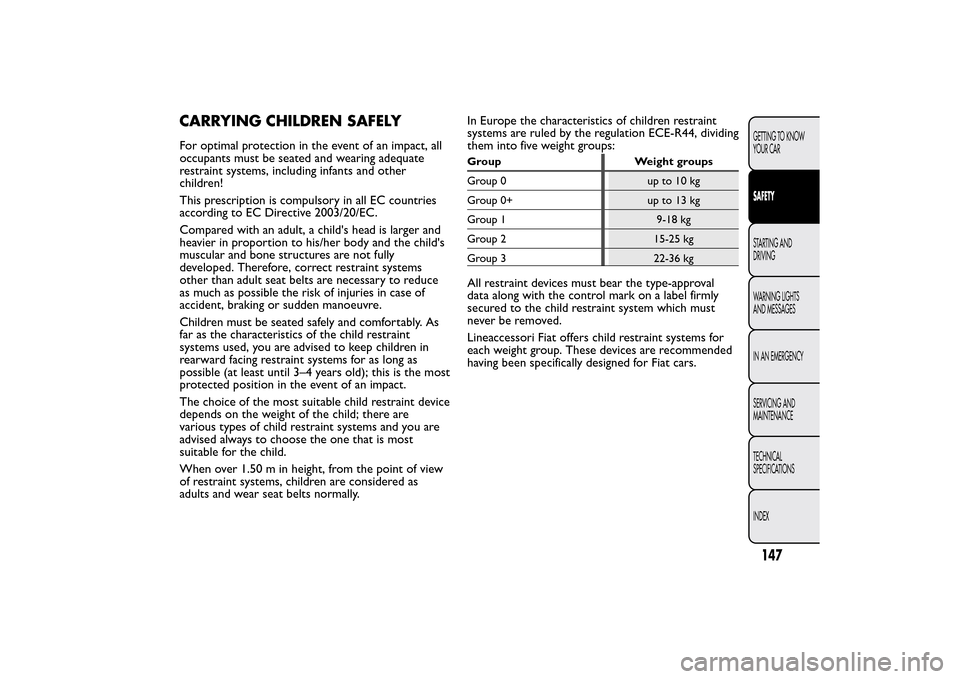
CARRYING CHILDREN SAFELYFor optimal protection in the event of an impact, all
occupants must be seated and wearing adequate
restraint systems, including infants and other
children!
This prescription is compulsory in all EC countries
according to EC Directive 2003/20/EC.
Compared with an adult, a child's head is larger and
heavier in proportion to his/her body and the child's
muscular and bone structures are not fully
developed. Therefore, correct restraint systems
other than adult seat belts are necessary to reduce
as much as possible the risk of injuries in case of
accident, braking or sudden manoeuvre.
Children must be seated safely and comfortably. As
far as the characteristics of the child restraint
systems used, you are advised to keep children in
rearward facing restraint systems for as long as
possible (at least until 3–4 years old); this is the most
protected position in the event of an impact.
The choice of the most suitable child restraint device
depends on the weight of the child; there are
various types of child restraint systems and you are
advised always to choose the one that is most
suitable for the child.
When over 1.50 m in height, from the point of view
of restraint systems, children are considered as
adults and wear seat belts normally.In Europe the characteristics of children restraint
systems are ruled by the regulation ECE-R44, dividing
them into five weight groups:
Group Weight groups
Group0 upto10kg
Group 0+ up to 13 kg
Group 1 9-18 kg
Group 2 15-25 kg
Group 3 22-36 kgAll restraint devices must bear the type-approval
data along with the control mark on a label firmly
secured to the child restraint system which must
never be removed.
Lineaccessori Fiat offers child restraint systems for
each weight group. These devices are recommended
having been specifically designed for Fiat cars.
147GETTING TO KNOW
YOUR CARSAFETYSTARTING AND
DRIVING
WARNING LIGHTS
AND MESSAGES
IN AN EMERGENCY
SERVICING AND
MAINTENANCE
TECHNICAL
SPECIFICATIONS
INDEX
Page 152 of 420
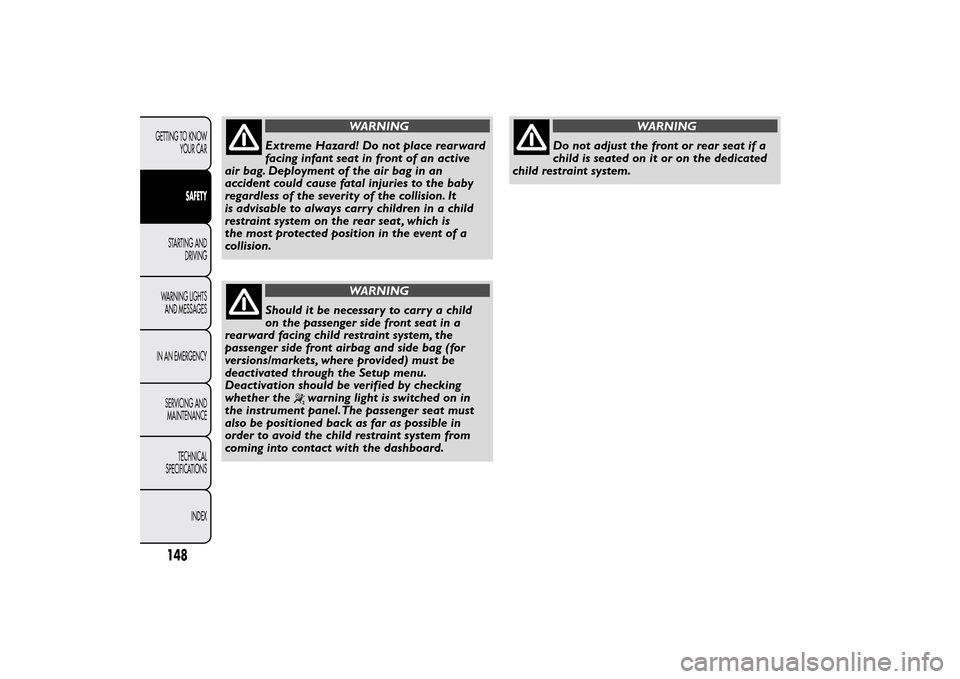
WARNING
Extreme Hazard! Do not place rearward
facing infant seat in front of an active
air bag. Deployment of the air bag in an
accident could cause fatal injuries to the baby
regardless of the severity of the collision. It
is advisable to always carr y children in a child
restraint system on the rear seat , which is
the most protected position in the event of a
collision.
WARNING
Should it be necessary to carry a child
on the passenger side front seat in a
rearward facing child restraint system, the
passenger side front airbag and side bag (for
versions/markets, where provided) must be
deactivated through the Setup menu.
Deactivation should be verified by checking
whether the
warning light is switched on in
the instrument panel.The passenger seat must
also be positioned back as far as possible in
order to avoid the child restraint system from
coming into contact with the dashboard.
WARNING
Do not adjust the front or rear seat if a
child is seated on it or on the dedicated
child restraint system.
148GETTING TO KNOW
YOUR CAR
SAFETY
STARTING AND
DRIVING
WARNING LIGHTS
AND MESSAGES
IN AN EMERGENCY
SERVICING AND
MAINTENANCE
TECHNICAL
SPECIFICATIONS
INDEX
Page 153 of 420
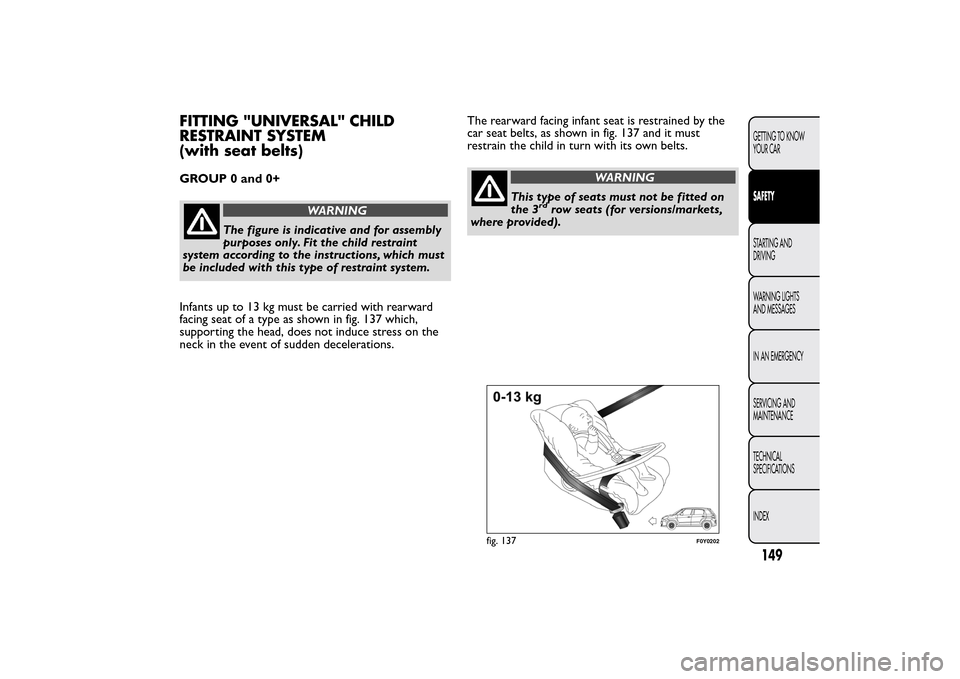
FITTING "UNIVERSAL" CHILD
RESTRAINT SYSTEM
(with seat belts)GROUP 0 and 0+
WARNING
The figure is indicative and for assembly
purposes only. Fit the child restraint
system according to the instructions, which must
be included with this type of restraint system.
Infants up to 13 kg must be carried with rearward
facing seat of a type as shown in fig. 137 which,
supporting the head, does not induce stress on the
neck in the event of sudden decelerations.The rearward facing infant seat is restrained by the
car seat belts, as shown in fig. 137 and it must
restrain the child in turn with its own belts.
WARNING
This type of seats must not be fitted on
the 3
rd
row seats (for versions/markets,
where provided).
fig. 137
F0Y0202
149GETTING TO KNOW
YOUR CARSAFETYSTARTING AND
DRIVING
WARNING LIGHTS
AND MESSAGES
IN AN EMERGENCY
SERVICING AND
MAINTENANCE
TECHNICAL
SPECIFICATIONS
INDEX
Page 154 of 420
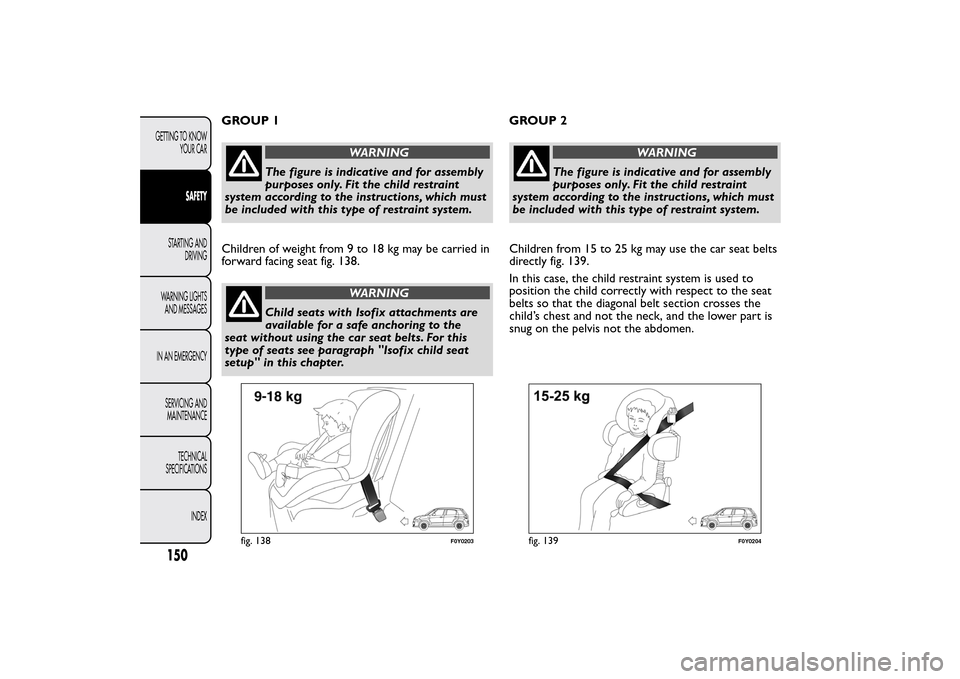
GROUP 1
WARNING
The figure is indicative and for assembly
purposes only. Fit the child restraint
system according to the instructions, which must
be included with this type of restraint system.
Children of weight from 9 to 18 kg may be carried in
forward facing seat fig. 138.
WARNING
Child seats with Isofix attachments are
available for a safe anchoring to the
seat without using the car seat belts. For this
type of seats see paragraph "Isofix child seat
setup" in this chapter.GROUP 2
WARNING
The figure is indicative and for assembly
purposes only. Fit the child restraint
system according to the instructions, which must
be included with this type of restraint system.
Children from 15 to 25 kg may use the car seat belts
directly fig. 139.
In this case, the child restraint system is used to
position the child correctly with respect to the seat
belts so that the diagonal belt section crosses the
child’s chest and not the neck, and the lower part is
snug on the pelvis not the abdomen.
fig. 138
F0Y0203
fig. 139
F0Y0204
150GETTING TO KNOW
YOUR CAR
SAFETY
STARTING AND
DRIVING
WARNING LIGHTS
AND MESSAGES
IN AN EMERGENCY
SERVICING AND
MAINTENANCE
TECHNICAL
SPECIFICATIONS
INDEX
Page 155 of 420
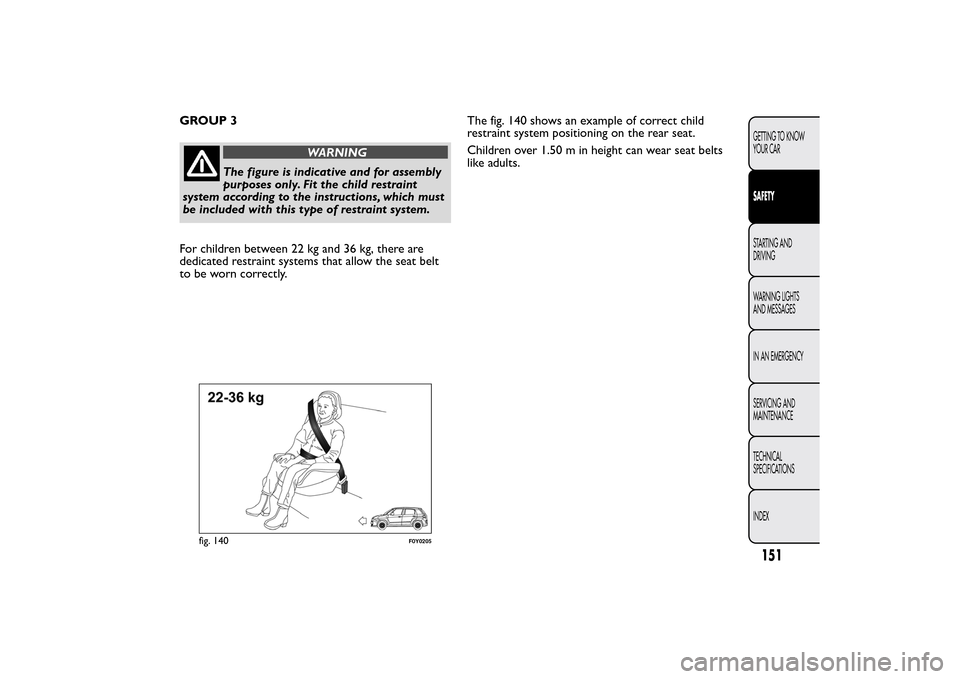
GROUP 3
WARNING
The figure is indicative and for assembly
purposes only. Fit the child restraint
system according to the instructions, which must
be included with this type of restraint system.
For children between 22 kg and 36 kg, there are
dedicated restraint systems that allow the seat belt
to be worn correctly.The fig. 140 shows an example of correct child
restraint system positioning on the rear seat.
Children over 1.50 m in height can wear seat belts
like adults.
fig. 140
F0Y0205
151GETTING TO KNOW
YOUR CARSAFETYSTARTING AND
DRIVING
WARNING LIGHTS
AND MESSAGES
IN AN EMERGENCY
SERVICING AND
MAINTENANCE
TECHNICAL
SPECIFICATIONS
INDEX
Page 156 of 420
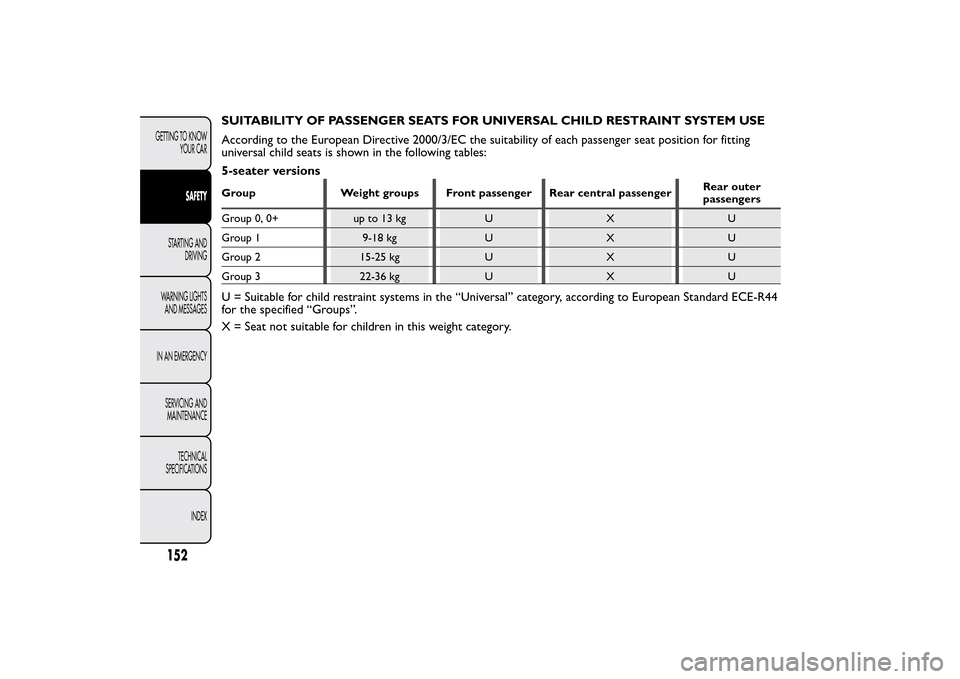
SUITABILITY OF PASSENGER SEATS FOR UNIVERSAL CHILD RESTRAINT SYSTEM USE
According to the European Directive 2000/3/EC the suitability of each passenger seat position for fitting
universal child seats is shown in the following tables:
5-seater versionsGroup Weight groups Front passenger Rear central passengerRear outer
passengers
Group 0, 0+ up to 13 kg U X U
Group 1 9-18 kg U X U
Group 2 15-25 kg U X U
Group 3 22-36 kg U X UU = Suitable for child restraint systems in the “Universal” category, according to European Standard ECE-R44
for the specified “Groups”.
X = Seat not suitable for children in this weight category.
152GETTING TO KNOW
YOUR CAR
SAFETY
STARTING AND
DRIVING
WARNING LIGHTS
AND MESSAGES
IN AN EMERGENCY
SERVICING AND
MAINTENANCE
TECHNICAL
SPECIFICATIONS
INDEX
Page 157 of 420
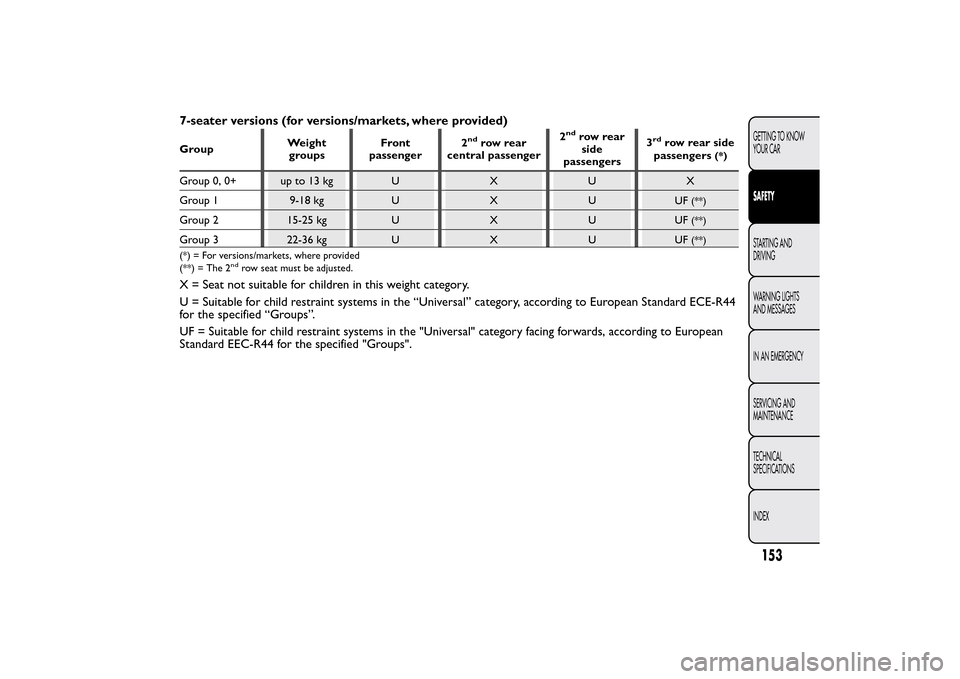
7-seater versions (for versions/markets, where provided)GroupWeight
groupsFront
passenger2
nd
row rear
central passenger2
nd
row rear
side
passengers3
rd
row rear side
passengers
(*)
Group0,0+upto13kgUXUX
Group 1 9-18 kg U X U
UF
(**)
Group 2 15-25 kg U X U
UF
(**)
Group 3 22-36 kg U X U
UF
(**)
(*) = For versions/markets, where provided
(**) = The 2
ndrow seat must be adjusted.
X = Seat not suitable for children in this weight category.
U = Suitable for child restraint systems in the “Universal” category, according to European Standard ECE-R44
for the specified “Groups”.
UF = Suitable for child restraint systems in the "Universal" category facing forwards, according to European
Standard EEC-R44 for the specified "Groups".
153GETTING TO KNOW
YOUR CARSAFETYSTARTING AND
DRIVING
WARNING LIGHTS
AND MESSAGES
IN AN EMERGENCY
SERVICING AND
MAINTENANCE
TECHNICAL
SPECIFICATIONS
INDEX
Page 158 of 420
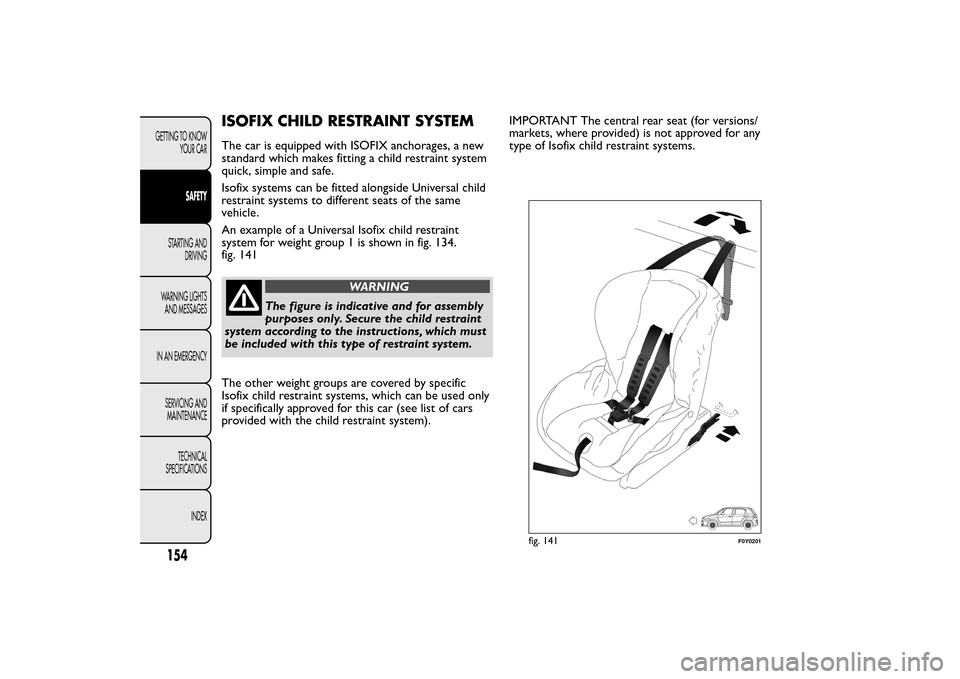
ISOFIX CHILD RESTRAINT SYSTEMThe car is equipped with ISOFIX anchorages, a new
standard which makes fitting a child restraint system
quick, simple and safe.
Isofix systems can be fitted alongside Universal child
restraint systems to different seats of the same
vehicle.
An example of a Universal Isofix child restraint
system for weight group 1 is shown in fig. 134.
fig. 141
WARNING
The figure is indicative and for assembly
purposes only. Secure the child restraint
system according to the instructions, which must
be included with this type of restraint system.
The other weight groups are covered by specific
Isofix child restraint systems, which can be used only
if specifically approved for this car (see list of cars
provided with the child restraint system).IMPORTANT The central rear seat (for versions/
markets, where provided) is not approved for any
type of Isofix child restraint systems.
fig. 141
F0Y0201
154GETTING TO KNOW
YOUR CAR
SAFETY
STARTING AND
DRIVING
WARNING LIGHTS
AND MESSAGES
IN AN EMERGENCY
SERVICING AND
MAINTENANCE
TECHNICAL
SPECIFICATIONS
INDEX
Page 159 of 420
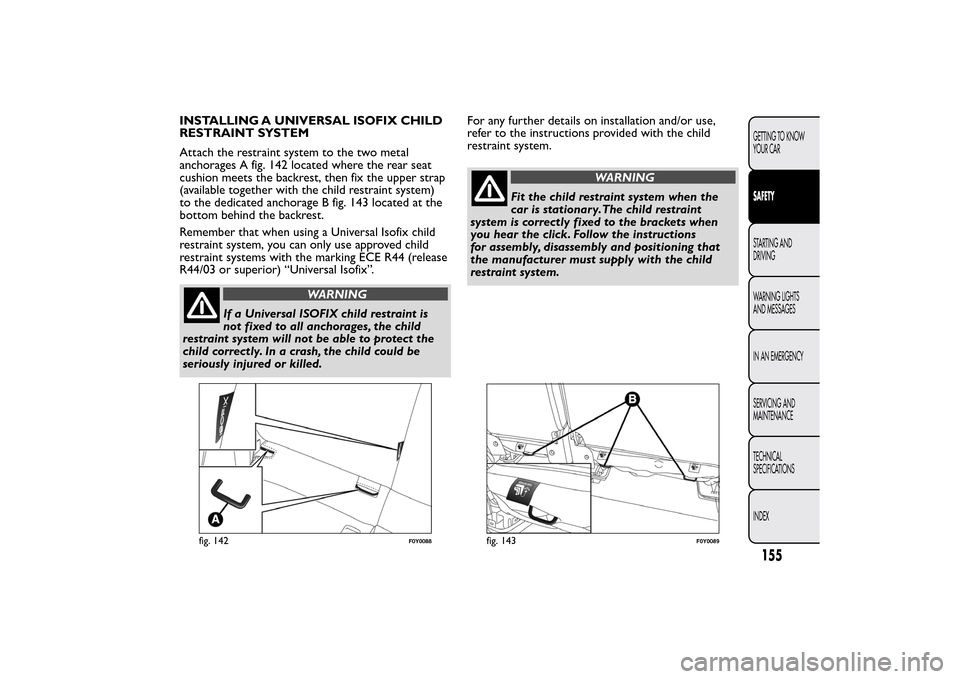
INSTALLING A UNIVERSAL ISOFIX CHILD
RESTRAINT SYSTEM
Attach the restraint system to the two metal
anchorages A fig. 142 located where the rear seat
cushion meets the backrest, then fix the upper strap
(available together with the child restraint system)
to the dedicated anchorage B fig. 143 located at the
bottom behind the backrest.
Remember that when using a Universal Isofix child
restraint system, you can only use approved child
restraint systems with the marking ECE R44 (release
R44/03 or superior) “Universal Isofix”.
WARNING
If a Universal ISOFIX child restraint is
not fixed to all anchorages, the child
restraint system will not be able to protect the
child correctly. In a crash, the child could be
seriously injured or killed.For any further details on installation and/or use,
refer to the instructions provided with the child
restraint system.
WARNING
Fit the child restraint system when the
car is stationary.The child restraint
system is correctly fixed to the brackets when
you hear the click. Follow the instructions
for assembly, disassembly and positioning that
the manufacturer must supply with the child
restraint system.
fig. 142
F0Y0088
fig. 143
F0Y0089
155GETTING TO KNOW
YOUR CARSAFETYSTARTING AND
DRIVING
WARNING LIGHTS
AND MESSAGES
IN AN EMERGENCY
SERVICING AND
MAINTENANCE
TECHNICAL
SPECIFICATIONS
INDEX
Page 160 of 420
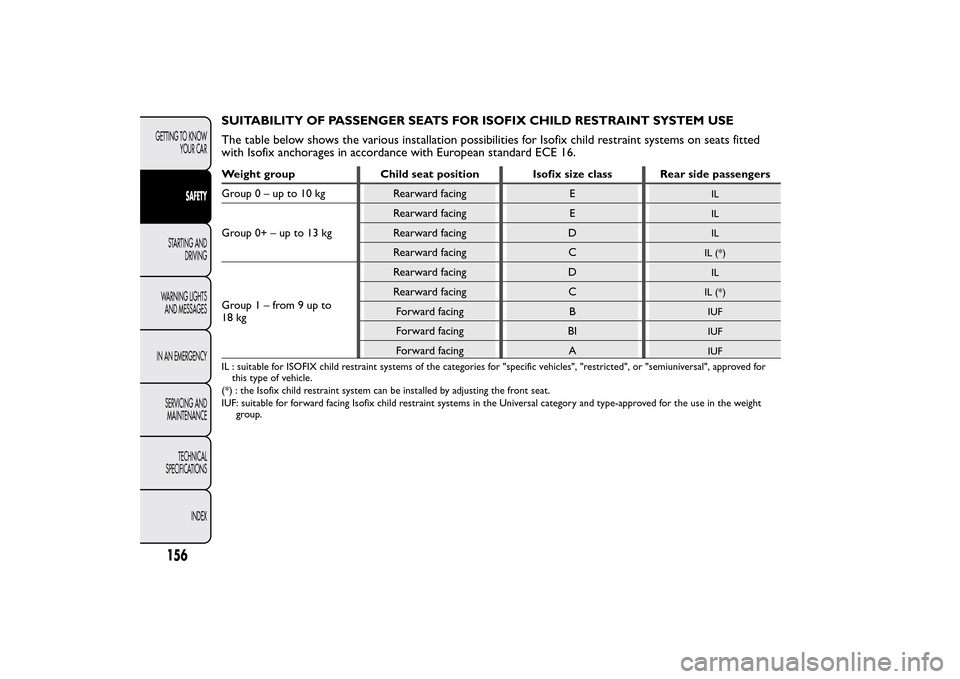
SUITABILITY OF PASSENGER SEATS FOR ISOFIX CHILD RESTRAINT SYSTEM USE
The table below shows the various installation possibilities for Isofix child restraint systems on seats fitted
with Isofix anchorages in accordance with European standard ECE 16.Weight group Child seat position Isofix size class Rear side passengers
Group0–upto10kg Rearwardfacing E
IL
Group0+–upto13kgRearward facing E
IL
Rearward facing D
IL
Rearward facing C
IL (*)
Group1–from9upto
18 kgRearward facing D
IL
Rearward facing C
IL (*)
Forward facing B
IUF
Forward facing BI
IUF
Forward facing A
IUF
IL : suitable for ISOFIX child restraint systems of the categories for "specific vehicles", "restricted", or "semiuniversal", approved for
this type of vehicle.
(*) : the Isofix child restraint system can be installed by adjusting the front seat.
IUF: suitable for forward facing Isofix child restraint systems in the Universal category and type-approved for the use in the weight
group.
156GETTING TO KNOW
YOUR CAR
SAFETY
STARTING AND
DRIVING
WARNING LIGHTS
AND MESSAGES
IN AN EMERGENCY
SERVICING AND
MAINTENANCE
TECHNICAL
SPECIFICATIONS
INDEX